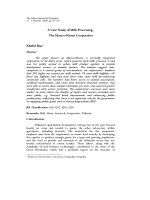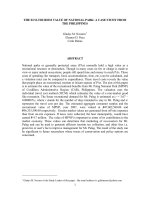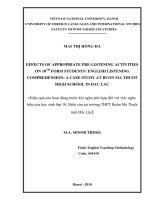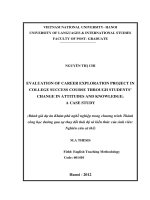- Trang chủ >>
- Đề thi >>
- Đề thi lớp 9
Surgical removal of periodontal traumatic incisor tooth along with gingiva in a buffalo: A case study - TRƯỜNG CÁN BỘ QUẢN LÝ GIÁO DỤC THÀNH PHỐ HỒ CHÍ MINH
Bạn đang xem bản rút gọn của tài liệu. Xem và tải ngay bản đầy đủ của tài liệu tại đây (286.29 KB, 4 trang )
<span class='text_page_counter'>(1)</span><div class='page_container' data-page=1>
<i><b>Int.J.Curr.Microbiol.App.Sci </b></i><b>(2017)</b><i><b> 6</b></i><b>(11): 1620-1623 </b>
1620
<b>Case Study </b>
<b>Surgical Removal of Periodontal Traumatic Incisor Tooth along with </b>
<b>Gingiva in a Buffalo: A Case Study </b>
<b>Sheikh Tajamul Islam*, Jatin Khurma, Priti Patel, Anand Kumar Singh, </b>
<b>Mohd Younis Ganaie, Rohini Gupta and Rafiq Ahmad Shah </b>
Department of Veterinary Medicine, International Institute of Veterinary Education and
Research (IIVER), Rohtak Haryana-124001, India
<i>*Corresponding author </i>
<i><b> </b></i> <i><b> </b></i><b>A B S T R A C T </b>
<i><b> </b></i>
<b>Introduction </b>
Cattle have 32 permanent teeth with a dental
formula of 2(incisors 0/4, premolars 3/3, and
molars 3/3). The temporary incisor teeth erupt
sequentially at approximately weekly
intervals from birth. The three temporary
premolar teeth erupt within two to six weeks.
The first permanent molar erupts at eight
months. The second permanent molar erupts
at nine to 12 months, and the third permanent
molar and permanent premolars erupt from 24
months. The first (central) pair of permanent
incisors erupt at 18 months and are fully in
wear by 24 months. The second (medials),
third (laterals) and fourth (corners) incisor
teeth erupt sequentially at six months'
intervals; 30 month-old cattle having four
broad (adult) teeth.
Congenital abnormalities including cleft
palate, prognathia and brachygnathia are rare
<i>International Journal of Current Microbiology and Applied Sciences </i>
<i><b>ISSN: 2319-7706 Volume 6 Number 11 (2017) pp. 1620-1623 </b></i>
Journal homepage:
This case report describes surgical removal of 3rd permanent corner incisor tooth along
with hemorrhagic gingiva in buffalo caused due to oral trauma. The case was presented at
Teaching Veterinary Clinical Complex, International Institute of Veterinary Education and
Research (IIVER) Rohtak Haryana, with history of drooling of saliva, anorexia, absence of
mastication and bleeding from mouth. Clinical examination revealed traumatic and
hemorrhagic swollen area in 3rd permanent corner incisor tooth gingiva of lower jaw.
Swollen area was hard, hot, painful and hemorrhagic. After the clinical observations and
complete anamnesis from owner, it was confirmed as traumatic periodontitis and
the gingiva and bone that support the incissor tooth become seriously and irreversibly
damaged. The 3rd permanent corner incisor tooth along with hemorrhagic gingival was
removed under general (Xylazine) and local (2% Lignocaine) anesthesia. Xylazine was
injected @ 0.03-0.1 mg/kg BW. After successful removal of 3rd permanent corner incisor
tooth along with hemorrhagic gingiva. The gingiva was sutured by using cat-gut as
suturing material. The sutured edges were brought together without tension by simple
interrupted sutures. Owner was advised for postoperative treatment prescribed as penicillin
40000 IU/kg and streptomycin 12mg/kg IM for 7 days and 6 liters dextrose 5% IV,
meloxicam @ 0.5mg/kg BW IM, tribivet @ 15 mL total dose for 3 days. Owner was also
advised provide semi-solid food to animal for care and management of surgical site. The
animal recovered fruitfully.
<b>K e y w o r d s </b>
Buffalo, Hemorrhagic
gingiva, Incisor tooth,
Surgical removal
<i><b>Accepted: </b></i>
15 September 2017
<i><b>Available Online:</b></i>
10 November 2017
</div>
<span class='text_page_counter'>(2)</span><div class='page_container' data-page=2>
<i><b>Int.J.Curr.Microbiol.App.Sci </b></i><b>(2017)</b><i><b> 6</b></i><b>(11): 1620-1623 </b>
1621
and most lesions affecting the mouth are
caused by trauma and infection. Cattle with
lesions of the mouth usually present with
profuse salivation and poor abdominal fill due
to impaired feeding. Lesions affecting the
cheek result in obvious firm swellings.
Infected lesions of the cheek and/or tongue
may cause halitosis. Prognathia and
brachygnathia defects can be managed by
careful husbandry ensuring an adequate
concentrate component of the ration to
maintain growth rate to slaughter. Calves with
severe cleft palate are typically recognised by
the presence of milk at the nostrils when
sucking and are euthanased for welfare
reasons.
Abnormal regurgitation in ruminants is
defined as the discharge of food from the
mouth Dirksen <i>et al.,</i> (2002)and occasionally
from the nose Radostits <i>et al.,</i> (2007)
immediately after prehension of feed and
before the feed enters the fore stomach.
Affected cattle may suddenly stop eating,
extend the neck momentarily and after a brief
episode of retching, eject partially chewed
food mixed with saliva. Regurgitation must be
differentiated from vomiting; the latter
follows a short period of restlessness and is
characterised by a considerable amount of
fore stomach ingesta exiting the mouth or
nose with force Dirksen <i>et al.,</i> (2002). The
vomitus of ruminants contains rumen fluid
and small feed particles. While regurgitation
is a normal phenomenon in ruminants,
abnormal regurgitation is usually the result of
an oesophageal disorder, often affecting the
intrathoracic part. Causes include oesophageal
dilatation Morgan (1965) and Vestweber <i>et </i>
<i>al.,</i> (1985) and narrowing Alexander (1965),
various types of trauma, chemical irritation,
infection and parasites Dirksen <i>et al.,</i> (2002).
<b>History and clinical observation</b>
A buffalo was presented at Teaching
Veterinary Clinical Complex, International
Institute of Veterinary Education and
Research (IIVER) Rohtak Haryana, with
complaints of drooling of saliva, bleeding
from mouth, anorexia and absence of
mastication. Clinical examination revealed
traumatic and hemorrhagic swollen area in
mouth near base of 3rd permanent corner
incisor tooth gingiva of lower jaw (Figure 1).
Hemorrhagic swollen area was hard, hot and
painful on palpation. After the clinical
observations and complete anamnesis from
owner, it was confirmed as traumatic injury to
tooth which leads to periodontitis of 3rd
permanent corner incisor tooth and luxation
of tooth root. The gingiva was hemorrhagic
and swollen and bone that support the 3rd
permanent corner incisor tooth become
seriously and irreversibly damaged (Figure 1).
<b>Results and Discussion </b>
</div>
<span class='text_page_counter'>(3)</span><div class='page_container' data-page=3>
<i><b>Int.J.Curr.Microbiol.App.Sci </b></i><b>(2017)</b><i><b> 6</b></i><b>(11): 1620-1623 </b>
1622
<b>Fig.1</b> Showing traumatic tooth and hemorrhagic gingival and <b>Fig.2</b> Surgically removed tooth
along with hemorrhagic gingival
<b>Fig.3</b> Showing sutured gingiva after removal of hemorrhagic mass and tooth
The horse has normal host defenses that work to
maintain the integrity of the tissues that support
the tooth. A disruption of the defense
mechanisms results in an opportunistic infection
Klugh (2003). In small animal practice tooth
extraction is usually performed through the oral
approach under general anesthesia Taney <i>et al.,</i>
(2007). In horses the tooth extraction technique
is known as repulsion. It requires an osteotomy
or trephination to expose the roots of the
diseased tooth. Extraction is achieved by
driving/repelling the tooth into the mouth with a
dental punch Turner <i>et al.,</i> (1989). After
extraction, flushing and gentle debridement of
the alveolus removes loose fragments, debris
</div>
<span class='text_page_counter'>(4)</span><div class='page_container' data-page=4>
<i><b>Int.J.Curr.Microbiol.App.Sci </b></i><b>(2017)</b><i><b> 6</b></i><b>(11): 1620-1623 </b>
1623
(2005). This can be done using an intra-oral or
extra-oral approach. In all species, the
extraction site is generally sutured as this
enhances wound healing, prevents
contamination from food particles, stops
hemorrhage effectively and reduces
postoperative pain Dixon (2005) and DeBowes
<i>et al.,</i> (2005). This procedure is
contra-indicated, however, in cases of active infection
where one should allow drainage of infected
debris or discharges Fitch (2003) (11).
Providing extra-oral drainage to infected areas
after tooth extraction procedures (approached
through cortical bone) in lagomorphs and
horses, allows primary closure of the alveolus
Vlaminck <i>et al.,</i> (2007) (12). Postoperative
antibiotic administration is indicated in the
presence of an active infection; severe
periodontal disease or osteomyelitis, Smith
(2005), Verstraete (1983), and Vlaminck <i>et al.,</i>
(2007).
<b>References </b>
Alexander, J. E. 1964. Esophageal stricture in a
heifer. <i>Journal of American Veterinary </i>
<i>Medical Association</i>, 56:699–700.
DeBowes, L. J. 2005. Simple and Surgical
Exodontia. <i>Veterinary Clinics of North </i>
<i>America: Small Animal Practice,</i> 35(4),
963-84.
Dirksen, G., Gründer, H. D., Stöber, M. 2002.
Berlin: Parey Buchverlag. <i>Krankheiten </i>
<i>der </i> <i>Verdauungsorgane </i> <i>und </i> <i>der </i>
<i>Bauchwand,</i> 535–539.
Dixon, P. M., Dacre, I. 2005. A review of
equine dental disorders. <i>The Veterinary </i>
<i>Journal</i>, 169(2), 165-87.
Fitch, P. F. 2003. Surgical extraction of the
maxillary canine tooth. <i>Journal of </i>
<i>Veterinary Dentistry</i>, 20:55-8.
Klugh, D. O. 2003. Equine periodontal disease.
In: <i>Proceedings of the 17th Annual </i>
<i>Veterinary Dental Forum</i>, 206-10.
Morgan, J. P. 1965 Esophageal dilatation in a
cow. <i>Journal of American Veterinary </i>
<i>Medical Association,</i> 56:411–412.
Radostits, O. M., Gay, C. C., Hinchcliff, K. W.,
Constable, P. D. 2007. <i>Veterinary </i>
<i>Medicine</i>. A Textbook of the Diseases of
Cattle, Horses, Sheep, Pigs and Goats. 10.
Philadelphia: Saunders Elsevier Vomiting
and regurgitation, 192–193.
Smith, M. M. 2005. Exodontics. <i>Veterinary </i>
<i>Clinics North American Small Animal </i>
<i>Practice</i>, 1998:1297-319.
Taney, K. G., Smith, M. M. 2006. Surgical
extraction of impacted teeth in a dog.
<i>Journal of Veterinary Dentistry</i>,
23:168-77.
Turner, A. S., McIlwraith, C. W. 1989.
Repulsion of cheek teeth. In: Turner AS,
McIlwraith CW, eds. Techniques in Large
Animal Surgery. 2 ed. Philadelphia, USA:
Lippincott, Williams and Wilkins, 235- 9.
Verstraete, F. J. 1983. Instrumentation and
technique of removal of permanent teeth
in the dog. Journal of South African
Veterinary Association, 54(4), 231-8.
Vestweber. J. G., Leipold, H. W., Knighton, R.
G. 1985. Idiopathic megaesophagus in a
calf: Clinical and pathological
features. <i>Journal of American Veterinary </i>
<i>Medical Association</i>, 56:1369–1370.
Vlaminck, L., Verhaert, L., Steenhaut, M.,
Gasthuys, F. 2007. Tooth extraction
techniques in horses, pet animals and
man. Post-extraction molariform tooth
drift and alveolar grafting in horses,
76:262-71.
<b>How to cite this article: </b>
Sheikh Tajamul Islam, Jatin Khurma, Priti Patel, Anand Kumar Singh, Mohd Younis Ganaie,
Rohini Gupta and Rafiq Ahmad Shah. 2017. Surgical Removal of Periodontal Traumatic Incisor
Tooth along with Gingiva in a Buffalo: A Case Study. <i>Int.J.Curr.Microbiol.App.Sci.</i> 6(11):
</div>
<!--links-->
Minimum Wages and Employment: A Case Study of the Fast-Food Industry in New Jersey and Pennsylvania pot
- 26
- 869
- 0








